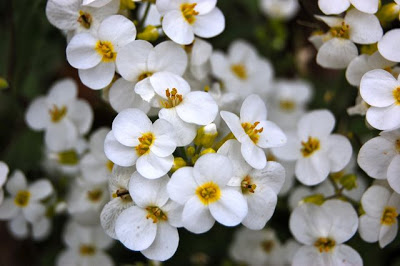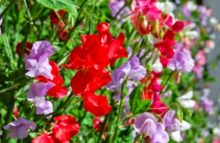For down-to-earth, spring flowering rock garden basics, you don’t have to go much further than the letter A.
Rock garden plants are often called by their own A name: alpines, because of their origins on mountainsides, thriving with sharp drainage and full sun. A well-drained, full-sun position is still is their favourite venue.
This is the season for what I have always know as Alyssum saxatilis, but which is more properly named Aurinia saxatilis. (It’s not to be confused with the annual sweet alyssum, which is really Lobularia maritima. Now you know. )
The common name is, appropriately, Basket of Gold. Above, you see it making a golden splash yesterday against a neighbour’s flowering quince (possibly Chaenomeles x superba). Whether you say alyssum or aurinia, these semi-evergreen, fuzzy leaved plants often expire if their feet are soggy over winter. Give them a little haircut after blooming to keep them compact.
 Next on our A-list is Arabis caucasia or rock cress. The plain old white one is vigorous enough to withstand my dry shade conditions, and blooms in a way that other usually tough customers (such as creeping phlox, Phlox subulata) don’t.
Next on our A-list is Arabis caucasia or rock cress. The plain old white one is vigorous enough to withstand my dry shade conditions, and blooms in a way that other usually tough customers (such as creeping phlox, Phlox subulata) don’t.
The variegated form, ‘Variegata’, with its pretty, white-trimmed leaves falls under the euphemistic plant category, “Effective, when well grown.” In my garden, it doesn’t get enough moisture in the front, and doesn’t get sharp enough drainage in the back, so has numerous times entered my long list of “Killed that!” plants. However, if you can offer it both, it’s to be preferred for its longer season of interest.
However, I’ll stick to the basics, and every year will add to my store. The repetition of white through the garden really helps hold the design, or lack thereof, together. I deadhead mine after they bloom, so they put their energies into vegetative increase rather than seed production.

The rich pinks, blues and purples of Aubrieta x cultorum — call it aubrieta for short — have long been a fave. But, as it always failed in my “better” back garden, I’d given it up.
Then about three years ago I thought, what the heck: give it a go in the front. The very dry, sharply sloped front bed, with only morning and late afternoon sun, seemed to be just what this lovely mat-forming plant wanted. It’s isn’t putting on the same display as it might in a full-sun position, but it’s not bad. And, on my dry shade bell curve, that gets an A from me.
These low-growing alpines are all members of the mustard family, Brassicaceae, making them cousins of cabbage and cauliflower. All are also called Crucifers, for their four-petalled, cross-shaped flower. It’s a good way to recognize these A-listers at the garden centre, no matter what name you give them.




